Old cookbooks sometime have the most intriguing recipes that you can tell just by reading if they will be a huge flop or completely delicious. This cookie recipe caught my eye and I actually didn’t know which it would be. So of course I had to try it. The cookie sounded rather delicate which is why it surprised me that it was baked twice like a biscotti. And why in the 1940’s it was called a French cookie is a mystery. Or maybe it actually is a French cookie. If there is an expert baker out there, please tell me if this cookie sounds French. What makes this even more fun is that this recipe is from my old stand-by of late, the Iowa church cookbook from 1949 which I have already written about twice this month. I almost didn’t tell you that because I was afraid you might think I don’t cook from anything else. Well, lately, I have been rather obsessed with reading it. It has so many good recipes I can’t put it down. What is it about these wonderful rural Iowa church ladies from the ’40’s and their great recipes? I love them.
Since it was a vintage recipe, I decided to use some of my old vintage baking items like the sifter for the flour, the old nut grinder, measuring cup, and scoop. One must get into the feel of the times, right? However, no Eiffel Tower in sight. (I put on some Chanel face cream this morning, does that count?)
The cookie is called “French Nut Sticks.” First butter and sugar are creamed together, eggs and vanilla are added, then sifted cake flour. The dough is patted out onto a jelly roll pan and covered with apricot jam and baked very briefly, only about 7-8 minutes. It cools for a few minutes before spreading on a topping of beaten egg whites, sugar, and a little flour and salt, and some chopped pecans folded in. It is then refrigerated until cold enough to cut into little sticks, squares, or however you would to cut them, and baked again until the meringue-pecan topping is golden and crackly.
The base of the cookie is like delicate golden shortbread, then a layer of apricot jam, and the meringue topping with the pecans is perfectly crunchy.
I loved the cookie, but also realized it is the kind of cookie that can be played around with to make with different flavor possibilities. Next time, I am going to add a little almond extract to the cookie base, use raspberry jam instead of apricot, and chopped almonds instead of pecans. Grated lemon peel could be added to the dough and then use lingonberry jam. Maybe even toasted coconut could go into the meringue. Think of the possibilities. What would you do with it? I would love to hear your ideas!
I was going to put the cookies in my cookie jar, but it’s not very vintage looking. I found an old bowl that belonged to my great-aunt and decided to pile the cookies into the bowl. What the heck, a cookie bowl. My husband was thrilled. He’s never seen a bowl filled with cookies before. I reminded him it was just for a fun photo, not to be eaten like a bowl of popcorn. That’s certainly not very French.
- ¾ cup salted butter, room temperature
- 2 cups sugar, divided
- 2 whole eggs
- 1 teaspoon vanilla
- 3 cups sifted cake flour
- 1 cup apricot jam
- 2 egg whites
- ⅛ teaspoon salt
- 1 Tablespoon all-purpose flour
- 1 cup finely chopped pecans
- Heat oven to 350 degrees. Lightly grease a jelly roll pan (15-1/2-by-10-1/2-by-1)
- In bowl of electric mixer, cream together butter and 1 cup of the sugar until light. Beat in the whole eggs, one at a time; beat in vanilla. Gradually add flour and beat until well blended. Place dollops of the dough all over the prepared pan, then pat down evenly. (Tip- the dough is a little sticky, so use slightly dampened hands to pat down the dough).
- Place the jam in a small bowl and stir with a spoon to loosen up, breaking any very large pieces. Carefully spread jam over the dough in pan. Bake for 7-8 minutes or until the edges are just a little firm. Don't worry; the middle will seem raw, but that's okay. It hardens as it chills and it gets baked again. Remove from oven and place on wire rack for 10 minutes to cool slightly while preparing topping.
- Beat the egg whites and salt until frothy. Gradually add the remaining 1 cup sugar that is combined with the 1 Tablespoon flour. Fold in chopped pecans. Spread mixture carefully and evenly over the jam.
- Place pan in refrigerator for at least 1 hour.
- When dough is cold enough to slice, first heat the oven to 375 degrees. Cut the dough into desired size pieces, squares or sticks. I cut mine into pieces 2 inches by 1-1/2 inches. Place the cut pieces on parchment-lined cookie sheets about an inch or so apart. (they do not spread, but get a little puffy). Bake for 14-15 minutes or until the tops are golden and getting puffy. Remove to wire racks to cool completely.


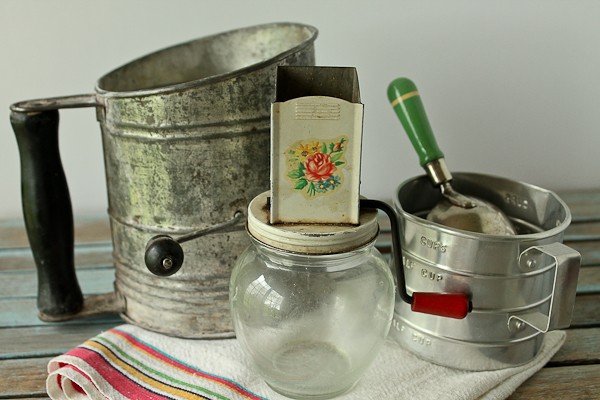
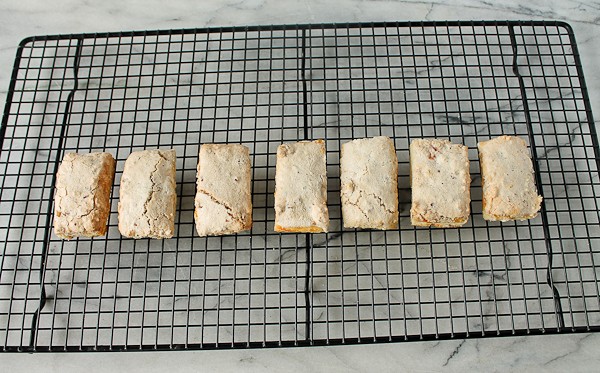
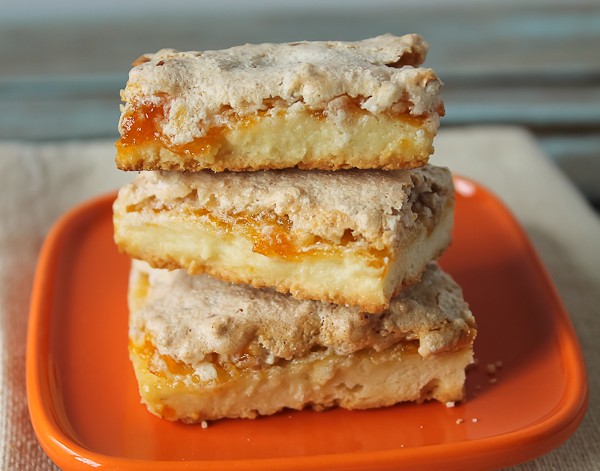
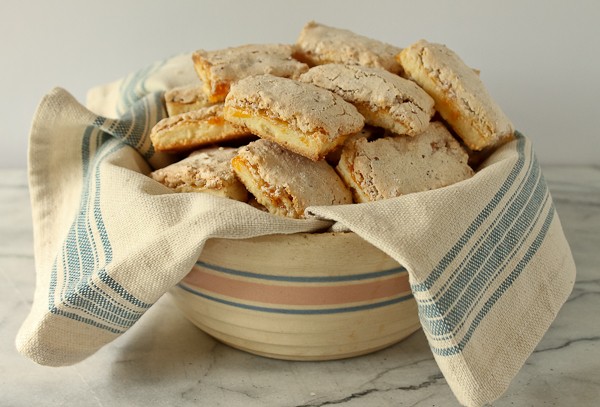
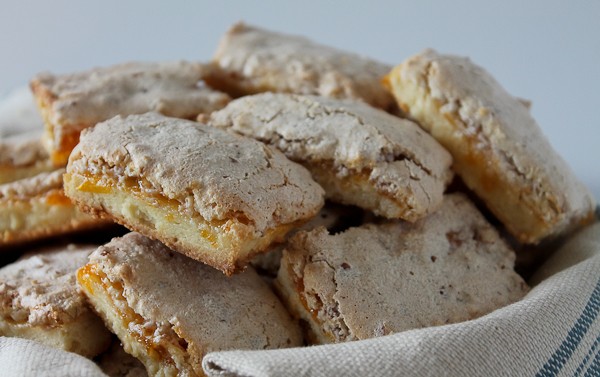






I like your coconut idea with maybe a pineapple-lime jam filling
Sounds really good, Lisa!
I love your vintage cooking utensils. I had completely forgotten the tin measuring cup my mother had, until I saw your photo!
I’m also intrigued by the choice of the word “French.” As you say, it could indicate a real connection to French cooking or just be a fancy word thrown around with no connection. I’m thinking “French” dressing (not French at all) or “French” beans (questionable). Or “French silk” ice cream (I have no idea why).
Mae, I am thinking more on the line of a fancy word thrown around, although the topping was sort of like a French macaron, so maybe that’s where it came from.
Hi Debbie!
I noticed your recipe and I read your intro, so I thought I’d reach out to you about these cookie bars. I am Chef Kathy from Louisville, Kentucky, and my grandmother, who lived in upstate New York, used to make this recipe for me as a child when she would come to visit our family. She was an immigrant from Budapest, Hungary, in 1903 and her mother (my great grandmother) made this same recipe for her when she was a child and called it Hungarian Pastry. The only difference is she used toasted walnuts instead of pecans and didn’t do the “twice-baked” portion of the recipe. It seems to me that the addition of twice baking step simply makes a cleaner-cut end product by cutting before the meringue is baked so it won’t shatter. Anyway, I can’t answer if it originated in France, but I do know it came to upstate New York via Hungary. 🙂
Best,
Kathy
Hi Kathy- I loved your explanation of the French cookie, which may not be French at all! It’s so interesting to learn where a recipe originated. How wonderful to learn that your Hungarian great-grandmother made these too. Sadly, since writing this blog, the cookbook was lost to a flood, and I can’t tell you how much I miss it. It was one of my treasured cookbooks from my beloved great-aunt. I will never be able to replace it, and glad that I featured recipes from it a few times. Thank you so much for writing.
This is just like the pastry MY Hungarian grandmother made. She lived in Queens but also had what we called her country house in upstate New York. Oh, and I have a younger sister named Kathy!
All: So excited to find and read this exchange! My Hungarian grandmother, my great aunt, and my mother made a similar bar cookie, whose recipe is a bit of a misnomer – it is titled “Lindzer Torte”. The proportions are different, but it is a similar recipe. One difference is that the bottom layer was baked a bit before spreading the apricot jam on top. Then the meringue is added and the full pan is baked prior to cutting into diamond shapes. I have been searching for a way to make the cut cookie look a bit more finished – cutting the cooked meringue leaves a jagged edge – – I may try the technique you described here. Regardless, these are delicious and a treasured food memory.
Debbie, I am sorry about the flood and the loss of your great aunt’s cookbook.
Mary Kay, your story brought tears to my eyes. I loved reading about your grandmother, mother, and great aunt, as I had the same wonderful trio in my life too. I miss them all the time, and especially at Christmas when we all enjoyed our favorite cookies. I have never stopped thinking about that lovely cookbook of my great aunt’s that was lost in the flood. I don’t think I will ever be able to find it again. Thank you so much for sharing your story and description of the “Lindzer Torte.” Wishing you a blessed holiday season with beautiful memories.
My grandmother, a survivor of the Holocaust and immigrant from Poland via Vienna and Budapest, made these for us when were little (and they were my absolute favorite desserts). She called them “Maria Theresa Schnitten” and her version had toasted walnuts lightly sprinkled over the meringue. I can’t recall if she twice-baked them but I doubt that she would for the aesthetics. It was all about efficiency and getting treats to her grandkids as quickly as possible!
Noel, thank you for that amazing story. I am going to call these “Maria Theresa Schnitten” from now on. God bless your grandmother.
Debbie- You are incredibly kind and generous to honor my grandmother in this way. Thank you very much, and wishing you the best always! Happy Holidays!
Thank you, Noel All the best and Happy Holidays to you too.
Hi Debbie! I was so excited to find this recipe! It matches a recipe card I have from my mother. She called then Colin’s Cookies (my brother) but under wrote Russian Apricot Cookies. These were made every year at Christmas and were a favorite by all, especially Colin! She also used walnuts instead of pecans but I wonder if that had to do with pricing and haven’t by a large family!
Hi Cherie- I’m thrilled to hear these cookies are like your mother’s, and just in time for Christmas baking! I love that she named them for your brother. I have recipes with family names in the title too. It makes them even more special. Thank you so much for writing.
This the identical recipe that I have been making every Christmas since 1969, I think. It has always been a favorite, and they were called French Nut Sticks. I got the recipe from someone I worked with, so don’t know the origin. I shared the recipe, and it became a favorite of my mother, too. I have always followed the recipe exactly until this year. I forgot to get apricot preserves, and I happened to have ginger preserves on hand. As I love ginger, I thought they would be better. They’re good, but I miss the apricot. I’ll not mess with perfection again.
Karen, thank you so much for your memories of this cookie. I love ginger too, so I appreciate your experience using the ginger preserves. From the comments here and emails I have received, the cookie seems to be a family favorite for many.